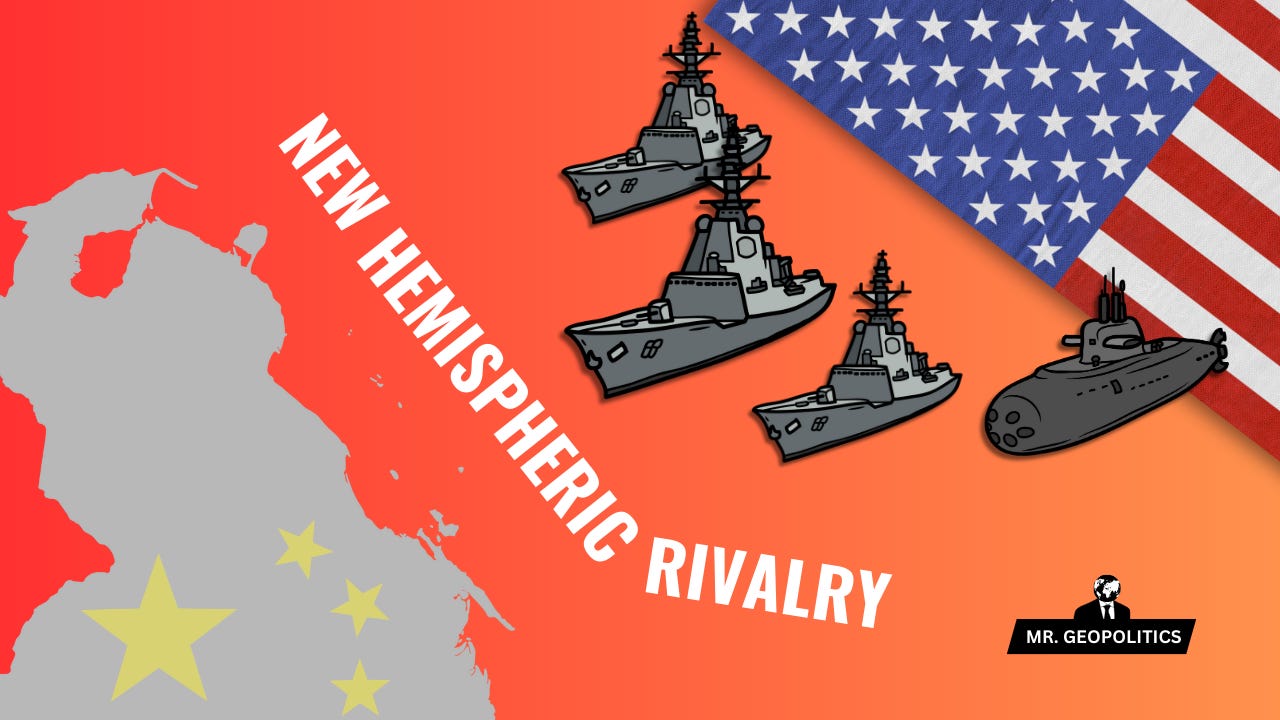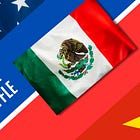US–Venezuela Fight Threatens New "Hemispheric Rivalry"
A clash that could disrupt energy flows, trade, and alliances
Within the past week, tensions between the US and Venezuela have exploded, pushing both sides closer to a military confrontation. The last time these conditions existed was in 2019, when a political crisis formed in Venezuela as Juan Guaidó, recognized by the West as the legitimate leader of the country, faced off against incumbent Nicolas Maduro, resulting in Trump 1.0 debating military force against the regime in Caracas.
But today, the situation is far more dangerous. US naval assets are amassing in the Caribbean and on Latin America’s Pacific coast, including advanced warships and submarines. The word from the White House is “dismantling drug trafficking.”
The door is opening to a new, disruptive geoeconomic fight with global consequences.
📣 POPULAR INSIGHTS ON THIS TOPIC
The US has said military action is not yet on the table and has not made any reference to a specific country. However, Venezuela believes it is in the crosshairs, leading to Maduro taking a range of steps, including deploying Venezuelan warships and drones to defend its shoreline, and activating 4.5 million people that are part of the country’s militia to patrol the coast—almost 2,500 miles long. Most powerfully, Maduro threatened to declare a “republic in arms,” effectively converting Venezuela into a wartime state.
A few months ago, US military assets were building up in a separate part of the world: the Middle East. The result was America’s first direct strikes on Iran. A repeat of this may be looming in South America.
If the US does strike Venezuela directly or indirectly to thwart drug movements, it will fundamentally change the geopolitics of the region, including trade, economy, and integration. Even though Venezuela is largely isolated in the world, as one of the ten most sanctioned countries, a military fight with America, even if only briefly, threatens profound shifts.
NEW HEMISPHERIC RIVALRY
The biggest is a return to the Cold War, when South American states were at odds with America over interventions, coups, and grand power competition that disrupted their economies and societies.
Strikes on Venezuela will not result in Caracas backing down.
The Maduro government has to present itself as the “strongman,” similar to the position Iran was put in after the US hit its nuclear sites. Except Iran was bruised from a 12-day war with Israel. On the other hand, Venezuela may be ready to fight, reinforced by threats from Venezuela’s military to invade Guyana in the past. The conditions are forming for a back-and-forth between the US and Venezuela. Except Venezuela could struggle to reach US naval assets—after all, it has less than 40 boats in total, while America has almost 300. To hit America, Venezuela might strike US assets in the region, in particular, parts of Central America and the Caribbean, where American forces are present.
The moment this happens, it draws South America into the conflict.
Not only could Venezuela destabilize, causing an outflux of people into neighboring states that creates new economic and social strain, but if other countries are drawn into the war, it could spook investors. This is not only about Venezuela attacking South American states that have US forces. Just as Iran threatened to retaliate against nations that enabled American-Israeli strikes on its territory, so too, Venezuela could retaliate against countries that allow American missiles or fighter jets to pass through.
Social and economic crises could manifest, not in alignment with America, but in opposition to America.
Countries in Latin America, in particular Argentina, Brazil, Chile, and Peru, along with participation by Mexico, will have to manage shocks and instability from a US-Venezuela fight. Some of these governments could return to their Cold War outlook, viewing the US as interfering in regional affairs, driving new “hemispheric rivalry” between South American states and Washington. Consider that states like Brazil are already at loggerheads with America, compounding the tensions.
What this looks like, from more sovereign trade approaches to a united stance against American tariffs to new tie-ups with Russia and China, remains in the grey. But hemispheric rivalry will mean a permanent shift in how South America conducts its relationship with the US. And for the US, it means that while fighting with Venezuela may be short and brief, the consequences could be long-term and geoeconomic in nature.
WAR SHOCKWAVES
While this is the holistic shift that is likely to occur if the US and Venezuela go to war, there are several other shockwaves that could quickly follow. Three of them stand out.
First, while Venezuela might retaliate militarily against the US, this is not sustainable long-term. Short of US forces entering Venezuela (low probability), Venezuela cannot fight America in the air or sea. This will be an asymmetric war. And part of Maduro’s “retaliation” could be to unleash drug supplies. These cartels, which the US has linked directly to the Maduro government, could be given the green light to dump drugs in American cities—or even commit crime.
By doing this, Venezuela will be turning to the black market to play geopolitics. But, by giving the cartels approval to move bigger quantities, with the official blessing of the Venezuelan government, the black market will move into the light—a strange paradox. Once again, unofficial trade channels could begin to define geopolitics, mimicking what is happening out of the war in Ukraine, where Russia is exporting vast quantities of energy through the infamous shadow fleet.
Second, Venezuela’s closest partners are Russia and China. And while the list of nations circling the Sino-Russian alliance is growing, like India, the number of states that are “staunch allies” remains small. And after strikes on Iran, who Beijing and Moscow can turn to for support is shrinking. This makes Venezuela critical.
The moment US strikes begin, Russia and China will have to play a role, beyond reassessing their own investments and economic exposure.
Depending on how severe the fighting becomes, they may also take measures to shield their partner. This could range from inking brand new investment deals in the midst of the war (i.e., China approving $20 billion to develop Venezuelan oil fields) to the movement of Russian and Chinese vessels off the Venezuelan coast. Such situations have occurred several times in the past. Most infamously, during the Cold War, in 1971, India and Pakistan went to war. The US was supporting Islamabad and moved a battle group (the Seventh Fleet) into the Bay of Bengal. In response, the Soviet Union dispatched its own naval fleet, made up of warships and submarines armed with nuclear weapons, also into the Bay of Bengal to ward off American activity and support New Delhi.
A similar situation could take place around Venezuela. Except, this time, Russia and/or China would be moving to defend Venezuela directly from the US—not from another state that America is backing.
Third, global oil supplies are front and center of a fight between the US and Venezuela. Until recently, Venezuelan oil exports were all about China. In June, for example, 90% of Venezuela’s oil went to China, directly, and through trans-shipment hubs (i.e., other states that then rebrand or reload oil from Venezuelan tankers onto new vessels for reexport to China). Some estimates put China’s reliance on Venezuelan oil at 4%—meaning Venezuelan oil imports supply 4% of China’s daily needs. While this might not be significant, it makes the US-Venezuela fight a disruptor of global energy markets and Chinese energy security. The US could take action against Venezuelan oil exports, most of which are shipped through what is known as the “dark fleet,” the Venezuelan version of a shadow fleet. These vessels could be targeted or even sunk if the fighting worsens. If China’s energy imports from Venezuela are knocked offline, the Chinese might increase imports from Russia and the Middle East, bringing back a prognostication from earlier this year that the world could dip into an “oil recession” as demand outstrips supply, in turn ramping up global energy prices.
Except, this is not just about China. Cuba imports around 70,000 barrels of oil a day. Around 45% of these imports, 32,000 barrels, come from Venezuela. If Venezuelan oil exports are knocked offline, Cuba could be pushed into a dangerous energy crisis. Such emergencies are never isolated. If Cuba needs energy, it will turn to its neighbors—or China and Russia. Pressure could build on other states to aid or assist, drawing them into the complex geopolitics.
Surrounding all of this, in August, the US restarted imports of Venezuelan oil, giving Chevron, its energy giant, permission to bring Venezuelan crude into America. While this oil trade has little bearing on US energy security, it does point to Washington seeking to bring Venezuelan oil back onto global markets. And, the reason could be to offset a potential economic fight between the US and Russia, which results in Moscow restricting oil supplies, raising prices (and inflation), particularly for the West. The hope may have been that Venezuelan oil could offset Russia’s squeeze. But if the US attacks, it loses control and leverage.
Venezuelan oil exports are not black and white. They are nuanced, overlapping, and their disappearance or disruption threatens global consequences and the strategies of both America and its main rivals. Ultimately, if regional pressure grows, like Cuba being in an energy emergency, the responsibility to manage this could fall on the US. meaning America would have to manage the blowback of its own decisions (striking Venezuela).
CONCLUSION
As the US sends more warships into the region, expected to arrive over the coming weeks, the situation remains fluid. Maduro has claimed over 1,200 missiles are pointed at his nation. And there is no clarity in the intelligence community as to what exactly America would target in terms of drug trafficking, and whether or not this would be effective.
Equally significant, and tying into everything, is the message America would be sending if it strikes Venezuela. Anybody harboring cartels could be hit. Will the US strike elsewhere in the region? And, shortly after the SCO summit in Tianjin, what takes place in Venezuela could be the biggest test for China and Russia. Will they leave their partners out in the cold or come to their rescue?
Much is unknown, much is grey, but the stakes are clear.
A fight between the US and Venezuela carries global consequences. It represents yet another geopolitical headache that governments and businesses must navigate, even if only dealing with higher energy prices. And it means that after wars in Europe, the Middle East, and Asia, war may be about to arrive in the Americas.
-ABISHUR PRAKASH AKA. MR. GEOPOLITICS
Mr. Geopolitics is the property of Abishur Prakash/The Geopolitical Business, Inc., and is protected under Canadian Copyright Law. This includes, but is not limited to: ideas, perspectives, expressions, concepts, etc. Any use of the insights, including sharing or interpretation, partly or wholly, requires explicit written permission.
Have questions or thoughts? Let’s talk: mrgeopolitics@substack.com
If you like Mr. Geopolitics, your colleagues might too.
Feel like doing something unique for somebody important?








